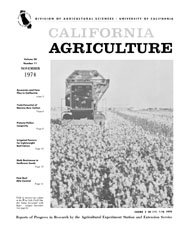All Issues










Volume 28, Number 11













|
|||
|
|||

Cover:
Field of narrow-row cotton at the West Side Field Station being harvested with finger - stripper harvester.

Cover:
Post-harvest wheel traffic reduced alfalfa stand and root development on sandy loam soil as shown in this photo taken during experiments at the San Joaquin Valley Research and Extension Center, Parlier.

Cover:
ERTS-I satellite photograph of Coachella Valley north of Salton Sea, and Imperial Valley to the south, with Mexican border visible (see “Remote Sensing in Control of Pink Bollworm in Cotton”).

Cover:
Two winged females and several larvae of European dusky-veined walnut aphids on upper leaf surface of a walnut leaflet.

Cover:
A 24-ft module builder for seed cotton in operation in the Sun Joaquin Valley. The hydraulically-powered compacter cylinder and support carriage are shown near the rear. Raised module builder being pulled off the completed module in lower photo.

Cover:
Shady Grove Dairy liquid manure holding pond near Chino. Top photo shows soil column installation on pond floor to right, and manometer installation on levee to left, allowing monitoring of seepage. Lower photo shows soil column being probed for sampling when pond was full with 8 ft. of dairy sewage.

Cover:
Typical design lor new combination pollination and pesticide duster being used in Coachella Valley date gardens.

Cover:
Both male and female flowers are seen on this branch of normally dioecious
Pistacia. Pistillate (left) and staminate (right) inflorescences at adjacent nodes are on a branch from a P. Vera x P. atlantica seedling.

Cover:
Eggs of the seed-destroying weevil, Rhinocyllus conicus, glued to a young flowerhead of milk thistle.

Cover:
'California' - a new fresh market pear variety for California features bright red-colored fruit that turns yellow when ripe. - Photo by Jack K. Clark.
November 1974
Volume 28, Number 11 General Information |
|||
|
University of California, 1301 S. 46th St., Bldg. 478 Richmond, CA
|